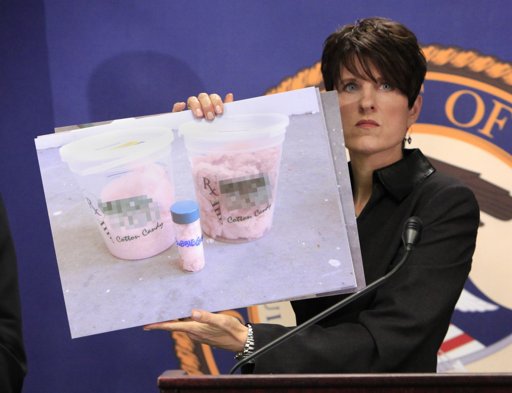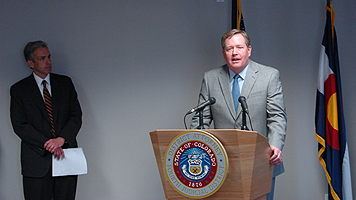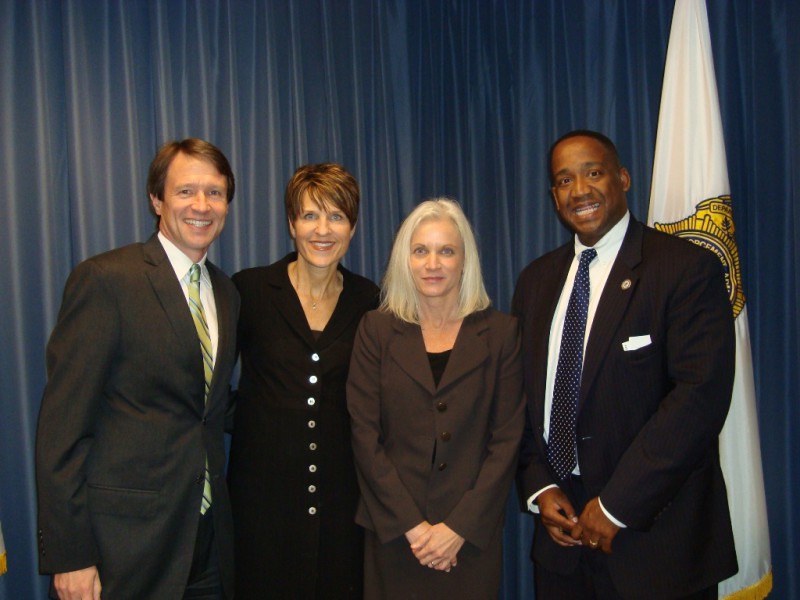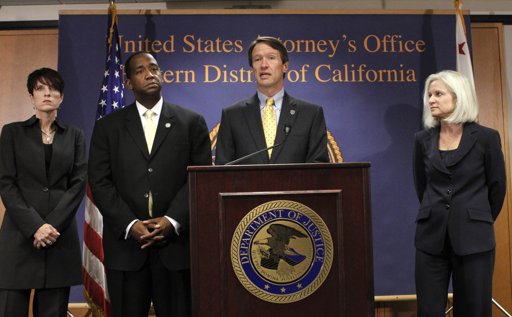
Others may not agree that pot cotton candy is a menace to mankind. But they’re not US Attorney for the Southern District of California, and Laura Duffy is.
After the recent crackdown on California dispensaries, many of you are concerned if similar disruptions can or will happen here in Colorado.
The short answer to “can it happen” is “yes.” The longer answer to “will it happen” is that similar hostilities don’t appear imminent in Colorado, but selling medical marijuana remains the single riskiest business in America.
Why would things be any different in Colorado than they were in California?
In September, 2010, 400 pot clubs, coops and collectives were subtracted from the Southern California landscape. The hit was ordered by the Los Angeles City Council — with plenty of advance warning, although few thought it would actually pass — and executed by the LAPD. That action was not instigated by US attorneys working for the federal prosecutor’s office or its enforcement arm, the DEA [Drug Enforcement Agency].
To the best of my knowledge, no one on the Denver City Council is calling for similar action.

Angel Raich’s states’ rights case made it all the way to the Supreme Court, which shot it down 6 – 3.
That leaves the aforementioned feds, in conjunction with the DEA, as the identifiable threat to Colorado dispensaries … and your “safe access to meds.” These forces had everything to do with the “smash and grab” raids on dispensaries from San Francisco to San Diego which made headlines earlier this month.
As many of you already know, the 2005 US Supreme Court decision in Gonzales vs. Raich established that federal anti-drug laws trump state laws that allow the use of medical marijuana. That decision grants the federal government license to do whatever it pleases with dispensaries. And planting “15-Minutes Only Parking” signs in front of them is not what I’m talking about.
The fact that Colorado MMJ laws are etched into the state constitution and California’s are not might deter similar raids. Don’t count on it. Ditto for the fact that California’s MMJ model is not-for-profit, while Colorado’s is for-profit. Don’t count on that, either.
With all that in mind, in order to determine how menacing the proposition of DEA raids on Denver dispensaries actually is, I called the DEA.
I’ve certainly discussed them enough. I’ve dissed, diced, and dissected them in article after article.
A perceived enemy that regularly burns up fields of a substance you hold dear is fodder for passionate prose.
But the deeper I dive into the socioeconomics of Ganja, Inc., the more I realize that the DEA is just one of many culprits responsible for the MMJ situation being as convoluted as it is.
At any rate, it was “high time” to get the story straight from the horse’s mouth.
I knew from past research that one of the DEA’s twenty-one Field Divisions is located right here in The Queen City of the Plains [Denver]. It’s unlikely they get a whole lot of inquiries from writers pounding the cannabis beat. When the agency feared and loathed by hundreds of millions [don’t forget the 70+ countries it operates in abroad] returned my call, I was momentarily taken aback.
Special Agent Robert M. “Mike” Turner blew away my conception of a DEA stereotype. He was accessible and well-spoken. If he’d ever been indoctrinated that cannabis is “the devil’s weed,” you’d never know it.
Look at what we’ve done, not what we haven’t done
“You have to basically look and see what we’ve done as opposed to what we haven’t done,” Mike began. “We’ve targeted major grow operations and a few dispensaries that are attached to them. We have not targeted patients.”
“We” is the DEA — not local or state police. They’re not one and the same.
“We’re not trying to scare anybody, but if you get too far out of the lane … you could become a target. It’s as simple as that.”
Without reading too much into what I reckon was straight shooting — as opposed to speaking in code — I didn’t sense that the DEA’s Denver Field Office is mobilizing forces to wipe Denver’s dispensaries off the face of the earth.
It’s definitely not on the warpath against patients.
“If you read the Ogden and Cole memos issued by the DOJ [Department of Justice], it’s very clear that we’re not gonna target sick individuals.”
Sick individuals might argue that “by closing my dispensary, you indirectly target me.”
That said, the DEA’s Denver Field Office hasn’t exactly been herding State of Colorado red card holders into corrals.
This holiday weekend, let’s give thanks that at least one DEA Special Agent expressed compassion for folks who mitigate their illnesses with the magical herb.
Is it a medicine?
 Understanding the DEA’s position comes down to the question of “is it a medicine?”
Understanding the DEA’s position comes down to the question of “is it a medicine?”
Did Mike think marijuana shows promise as a medicine?
“Researchers are always looking for those medicines that will cure disease and relieve pain effectively. Since I am not a scientist, I am not qualified to comment on whether it will ever be proven to be an actual medicine or even if it shows promise. The definition of a medicine has to be based on hard science, not on people voting for a substance to be declared a medicine. The FDA has to approve it based on science.”
My best guess is that Cannabis Commerce readers and folks on the Evergreen Apothecary email list will likely find that a provocative statement. But consider this: at least it’s a provocative statement, delivered diplomatically, which didn’t dismiss the prospect.
I couldn’t resist mentioning that Big Pharma employs hundreds if not thousands of lobbyists handsomely compensated to insure that the FDA never declares marijuana a medicine. But I didn’t press the point.
“Right now we don’t believe anything that’s smoked can be termed medicine,” Mike added.
Mike brought up the carcinogenic aspect several times. Cancer patient Bruce Vanaman also stated how much he hates putting carcinogens into his body during his extensive Cannabis Commerce interviews.
There was more.
“The DEA would not criticize a cancer patient or their family for the choice they might make in dealing with their family member’s suffering. There are other approved meds available to them. But we would never criticize their decision. We do have some concerns, however, for others who may use MMJ laws to profit significantly from them.”
That was the first of Mike’s three mentions that the amount of profit turned by MMJ businesses [they’d call them “operations”] affects whether or not they’re picked up by DEA radar.
What’s with the Schedule One drug classification?
I said earlier that I was coming around to the notion that the DEA may actually be less responsible than other entities for the randomness in marijuana laws and enforcement policies.
DEA employees are no more responsible for setting national drug policy than drug-sniffing dogs are responsible for authoring state MMJ laws.
Mike described the pecking order: “The DEA is under the DOJ but is not necessarily supervised by them, but we do operate under their policy. The US Attorneys operate under DOJ policy, but are not necessarily supervised by them. The DEA Administrator and the US Attorney General are appointed by the President. The Drug Czar sets the White House national drug policy and runs the ONDCP [Office of National Drug Control Policy].”
Perhaps all of them report to Big Pharma.

However, the DEA is responsible for drug scheduling.
And its perplexing classification of a roadside weed as a Schedule One drug along with cocaine, heroin, and Oxycontin has always seemed to defy logic.
“There are two things that qualify a drug for Schedule One,” Mike explained. “One is drugs that have no medically approved value. Two is drugs with a high propensity for abuse.”
Note that “drugs that are the most dangerous” is not part of the criteria.
From a law enforcement perspective, the ready availability of marijuana for under-aged teens does have “a high propensity for abuse.” Before anyone trots out typical pro-pot chestnuts like “no amount of marijuana has ever hurt anyone,” bear in mind that not all of the DEA’s budget is allotted for raiding pot businesses. Money is also earmarked for educational campaigns. That includes working with drug counselors who deal with cases of marijuana abuse in teens “that are not always pretty.”
Believe it or not, the #1 target for the DEA’s present campaign in this district is not marijuana abuse but prescription drug abuse. Hello, that means there’s common ground between the DEA’s current mission and one of the main selling points for MMJ.
Who they go after and who they don’t
“Are we out there running around Colorado looking for dispensaries to pop? No. Our job is going after major trafficking organizations. We’re looking for major operators, usually major operations with something else going on.” — DEA Special Agent Mike Turner
Examples of “something else going on” include:
- Selling to out of state buyers
- Buying from unregistered growers
- Affiliation with organized crime
- Trafficking in other “drugs” on the side
Mike continued:
“We’ve got other things to do than worry about than dispensaries. What have they got, a few pounds on site?”

DEA Denver Field Office Director Kevin R. Merrill [speaking] and US Attorney for Colorado John F. Walsh III announce an organized crime bust in Colorado Springs.
And, oh by the way, what does the Denver Field Division consider a major trafficking operation?
“There is no magic number. It depends on a lot of factors. But do we care about only a couple of pounds? Look at our history. The DEA is not busting people for a couple of pounds in Colorado. Local police might, state police might. That’s their jurisdiction. We go after organizations, not individuals.”
OK. That got me thinking. The vast majority of the 800,000 documented pot arrests annually in the US are made by local and state police, not the DEA. Interesting.
Then there are those big grow operations. Hold on to your seats.
“Commercial grows come within the scope of our office, because they’re big and they make a lot of money.”
There’s the second money mention. If you’re making a lot of money in a MMJ business, how does that affect you?
It’s safe to say that the more money you make, the squeakier-clean you better be. And you might want to roll in the silver Highlander instead of the black Hummer.
“Let’s say you’ve got a warehouse,” Mike continued. “The bigger the grow, the more you make, the more scrutiny you’ll receive. Let’s say you have a dispensary attached to a grow operation with something else going on. Then you’re pushing it.”
I’ll tiptoe around the issue of why the amount of money you make affects the amount of scrutiny you’ll receive. Just take it as a word to the wise that it matters. And please don’t twist that last quote into, “The DEA says it’s going after grow operations!”
“We’re not going after guys growing three or four plants,” Mike clarified. “We’ve never gone after any small caregivers in this district.”
Colorado HB 1280, which altered the caregiver laws, was authored by Matt Cook of the Colorado Department of Revenue, not the DEA or any federal agency.
Ever-changing MMJ regulations stress the DEA, too
Speaking of the Colorado Department of Revenue, its many examples of legislative ingenuity stress the DEA as much as dispensaries. The public is uncertain where local and state law enforcement ends and the DEA’s jurisdiction begins.
“It’s such a politically charged subject,” Mike offered. “Policies change all the time.”
And those policy changes are felt by the DEA, too.
The DEA is a federal agency, yet people for whatever reason expect it to enforce the State of Colorado’s medical marijuana laws — a set of laws which the DEA didn’t author and doesn’t even officially recognize.
Nonetheless, people call them when their neighbor’s growing a few dozen plants in an outdoor garden next to little Bobby’s swing set, when they pass an MMJ billboard or see a sign-twirler on a corner, or when they’re in a restaurant and the family unit picks up on the pungent tang of a grow operation next door.
Ever eaten at Bistro One next to Broadway Wellness when the MMC [medical marijuana center] kept hundreds of flowering plants onsite? They’re not making that up.
“It wasn’t so bad a few years ago when you had small caregivers growing for a few sick people. Now it’s gotten just crazy, the amount of money that’s being made.”
Third money mention duly noted.
May I humbly suggest that if you don’t like living in constant fear of crackdowns, closedowns, property seizures, search and grab operations, and government entities upset about the amount of money that people can earn in the medical marijuana field, you have an option available to you. That option would be working toward repealing prohibition. Repealing prohibition would actually rewrite federal laws, removing the federal vs. state gray areas that make life challenging for patients, dispensaries, and law enforcement personnel alike.
The DEA’s Relationship with the US Attorney’s Office

All four California US Attorneys smile for the camera at a press conference announcing their intention to enforce Gonzales vs. Raich. Prosecuting pot cases can be career makers for US Attorneys. US Attorney for Western Pennsylvania Mary Beth Buchanan rose to Director of the Executive Office for U.S. Attorneys after prevailing in the Tommy Chong “Operation Pipe Dreams” case.
“We don’t want to waste our time and resources popping someone if the case won’t be prosecuted,” Mike revealed. “So, the DEA always works in conjunction with a federal prosecutor. With limited resources, why work on a case that they’re not willing to prosecute?”
Makes sense.
“Where there’s leeway, or differences between who our Division chooses to go after compared to what California Divisions choose to pursue ― and you’ll have to ask them directly about their action, although I don’t think they’ll tell you ― is that there are different federal prosecutors in each section, and only so much money to prosecute every drug offender.”
“The federal prosecutors in California prioritized going after marijuana dispensaries. That doesn’t mean the federal prosecutor in Colorado will prioritize the issues here exactly the same.”
For the record, California has four federal prosecutors. Colorado has one, US Attorney John F. Walsh III, who was appointed by President Obama. Cannabis Commerce has a call into his office. [Update 12/9/2001: I’ve heard from attorney Walsh’s office. His media relations guy, Jeff Dorschner, gave me the preliminary lowdown that the Denver US Attorney’s office backs what Mike Turner said in this article. More after further discussions next week].
That begs the question: how much leeway does each US Attorney’s Office have?
“US attorneys have wide discretion. For example, a US attorney located near a border may have different priorities than a US attorney in our district.”
What California federal prosecutors [US attorneys] actually said earlier this month

US Attorney Benjamin Wagner announces the impending California dispensary crackdown.
“California’s marijuana industry supplies the nation,” said U.S. Attorney Benjamin Wagner, who represents the state’s Central Valley. “Huge amounts of marijuana grown here in this state is flowing east to other states, and huge amounts of money are flowing back in the opposite direction.”
Notice the “something else going on” aspect? And the “huge amounts of money” referenced? Recall that California is supposed to be a “not for profit” MMJ state ― unlike Colorado. Like it or not, attorney Wagner’s statement about huge amounts of money flowing in the opposite direction is true.
Here’s another one:
“The intention regarding medical marijuana under California state law was to allow marijuana to be supplied to seriously ill people on a nonprofit basis,” said U.S. Attorney Melinda Haag, the top federal law enforcement officer for the San Francisco Bay area. “What we are finding, however, is that California’s laws have been hijacked by people who are in this to get rich and don’t care at all about sick people.”
I’d like to see those statistics, but she’s entitled to her opinion.
Mike was more generous in his assessment of the local dispensary scene.
“Some people may have good intentions that open dispensaries. Just as many don’t.”
That statement undoubtedly has some truth to it. All in all, it’s a pretty reasonable statement coming from someone who actually has to face off with the “just as many who don’t.” Who are we talking about? “Russian mafia is definitely operating in this district.”
Getting back to the “something else going on” issue, I don’t believe it violates my pledge to Mike to refrain from stepping over his remarks to mention that the letter sent from Laura E. Duffy, federal prosecutor for the Southern California district, to San Diego dispensaries earmarked for extinction is very specific about the types of property she expects these businesses to voluntarily surrender ― while providing no information at all about any “hijacking,” pursuing “get rich quick” schemes, or “something else going on” at the targeted dispensaries.
Find it here:
Let’s all hope Mike is correct that in this DEA district something else needs to be going on for the agency to “break the truce.”
In closing…
“Marijuana in this field division is probably at the low end of the scale, Mike confided. “We’re more concerned with cocaine, methamphetamine, and heroin. The majority of cases are targeted organizations, regardless of what their major trafficking is.”
Then there’s no need for people to be looking over their shoulder every day?
“I don’t know. We try to tell people the truth, and the truth is that everyone is violating federal law. That said, around here we go after people that meet our criteria of major drug trafficking violators.”
p.s.
Yesterday’s Denver Post story, “Polls, dispensary bans show Coloradans are split over possibly legalizing marijuana,” by John Ingold catches up with a clear and present danger. And this danger is a reality more heinous than any imagined scenario the feds or the DEA might have up their sleeves in Colorado. What danger is that?
“Voters in 33 cities and towns — including three earlier this month — have now decided to ban medical-marijuana businesses in their communities. Voters in nine counties have decided to do the same for unincorporated areas of their counties.
When that’s combined with the 44 cities and 30 counties that have banned dispensaries through ordinance, more than 2 million people in Colorado — about 43 percent of the statewide population — live in areas where marijuana businesses are not allowed, according to a Denver Post analysis of lists provided by the Colorado Municipal League and Colorado Counties Inc.”
That would be the clear and present danger presented by your fellow citizens of Colorado!
You don’t always know from which direction the enemy will come …






5 comments
Aleka Stone says:
Nov 1, 2012
The article on DEA crackdown was very well written. Nice work!
tommy says:
Dec 18, 2012
I thought we were making some headway but after reading what you explain so well i know we need to have federal laws repealed not state level. I know how the government works on this and it doesn’t matter if you have 10 or 20 plants they still make you pay big time and I am very sick and have every right to use marijuana. To grow and use it anyway I want. The government just got way out of hand and its all about THE MONEY. Thank you for the education.
tommy says:
Dec 18, 2012
I would just like to add to this that marijuana is a plant and how can anyone make any plant put on earth and grows wild illegal?This goes beyound being wrong it should be illegal to make a plant illegal.
The Hemp Bong says:
Jan 20, 2013
I thought the recent crackdown on California dispensary was just bogus! The plant is NATURAL! Its not the plants fault that it was born with the properties it has! People should be able to do what they want when they want! just because someone tells you not to do something, makes you want to do it even more!
Cannabis Classifieds says:
Jun 7, 2013
As Bob Marley said, “It’s just a herb!” – so I think they should leave the plant alone…..